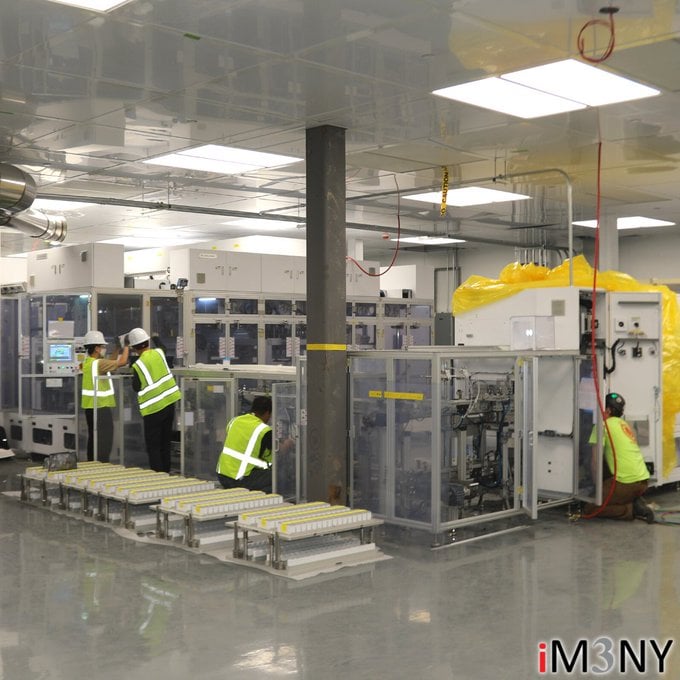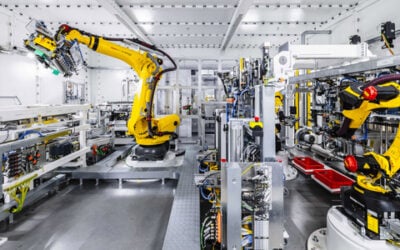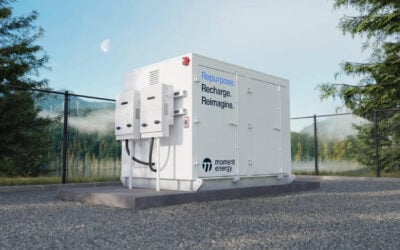
A lithium-ion battery factory has opened in New York State which could ramp-up to 38GWh annual production capacity by 2030, serving the electric vehicle (EV) and stationary battery storage sectors.
Australian vertically integrated battery tech and materials company Magnis Energy Technologies earlier this month announced the opening of the factory by its joint venture (JV) subsidiary Imperium 3 New York (iM3NY) in Endicott, a small village in rural Upstate New York.
Enjoy 12 months of exclusive analysis
- Regular insight and analysis of the industry’s biggest developments
- In-depth interviews with the industry’s leading figures
- Annual digital subscription to the PV Tech Power journal
- Discounts on Solar Media’s portfolio of events, in-person and virtual
iM3NY is majority-owned by Magnis and its technology partner at the plant, Charge CCCV (C4V). C4V claims to have developed a lithium manganese phosphate battery technology called BMLMP, with the ‘BM’ standing for Biomineralised cathode.
BMLMP cathode batteries operate at a higher voltage than other leading lithium sub-chemistries like lithium iron phosphate (LFP) and nickel manganese cobalt (NMC), while also not requiring cobalt or nickel for their production like NMC and various other sub-chemistries do.
The Endicott factory will produce prismatic cells designed to yield high mechanical integrity, ease of assembly and volumetric efficiency.
The production line is at the quality assurance stage to begin with, until late September, but will begin making cells for sale to customers after that and then increase annual production levels to 1GWh by the end of next year.
Longer terms plans are to ramp that up to 1.8GWh annual capacity, equivalent to 15,000 cells per day, and then to 38GWh annual production by 2030.
Magnis said the plant has been independently verified to be among the more sustainable battery production facilities around, by social impact consultancy Abt Associates, using as it does hydroelectric generation to power its production.
“The iM3NY team has put in a huge effort to achieve this major milestone of commercial production with iM3NY being North America’s only pure home-grown battery plant,” iM3NY CEO Chaitanya Sharma said.
“Despite a challenging global environment and supply chain issues, we have successfully started production close to schedule which is a major achievement. We now look forward to increasing production rates toward and over the gigawatt-hour mark.”
First of many
While it may be the first of its type in North America, it’s likely to be the first of many more gigafactories from US companies. Some that have specifically been announced to produce batteries for grid storage in addition to or even instead of vehicle batteries include a 12GWh factory in Buckeye, Arizona, thought to be at a late stage of development by US-headquartered startup KORE Power.
Recently, another group, American Battery Factory, claimed it could have a network of LFP gigafactories up and running within two years and another startup, SPARKZ, is developing a gigafactory in West Virginia which will make cobalt-free, solid-state lithium batteries suitable for grid applications.
Recent policy moves by the Biden-Harris Administration look like they could further the cause of domestically sited battery manufacturing, like the Bipartisan Infrastructure Law and the Inflation Reduction Act.
The administration has identified a need to bring more of the battery value chain into the US and outside of China, with the two pieces of legislation and others offering financial support to industry to do that.
That coupled with increased demand for batteries overall could lead to more onshoring of cell production in the US, senior director of manufacturing Peter Silveira at battery energy storage system (BESS) integrator and technology provider Fluence has already told Energy-Storage.news. Meanwhile, Kontromatik, a Turkish company, said last week that the Inflation Reduction Act has already persuaded its leadership to upsize a planned US factory from 2GWh to 3GWh.
Schumer invites zinc battery company to New York site
It’s not just lithium-ion battery companies that are likely to benefit from US policy support, Energy-Storage.news has heard from commentators including specialist energy sector lawyer Morten Lund from law firm Stoel Rives.
One of the politicians most instrumental in drafting the Inflation Reduction Act (IRA), Senate Majority Leader Chuck Schumer, has been working in the last few months to encourage zinc battery storage technology company Zinc8 to set up shop in his New York constituency.
On 12 August, the day the IRA passed in the Senate, Zinc8 signed a letter of intent to develop a manufacturing hub in iPark87, an industrial and technology campus in Ulster County, in New York’s Hudson Valley.
Zinc8 makes a zinc-air battery that can store and discharge energy over durations of up to 15 hours, scalable to higher capacities with an increase in the size of storage tanks that hold zinc particles. The technology is currently being trialed at a New York City housing complex by the New York State Energy Research and Development Agency (NYSERDA) where a 100kW/1.5MWh zinc BESS is being combined with onsite CHP generation.
Schumer had directly invited the company to make an application to become an anchor tenant at the iPark87 site. Zinc8 did not disclose the expected size or annual production capacity of the plant at this stage but did say it expects it to create 500 jobs in the area.
Zinc8 noted that Schumer had been instrumental in bringing it to the state. As well as his direct intervention at local level, the 45X Advanced Manufacturing Tax Credit included in the IRA provides incentives to battery manufacturers as well as to critical mineral processing companies.
Every eligible battery cell will receive a US$35 credit, scaling with the capacity of the battery, with incentives to last at their initial level until 2029, before phasing down from 2030 to a phase out stage beginning in 2032. There is also US$10 billion support available for construction of clean energy tech factories, or for retrofitting existing factories with tools and production lines to make clean energy equipment and components.
Meanwhile the Bipartisan Infrastructure Law, aka the Infrastructure Investment and Jobs Act, included US$6 billion incentives to support R&D and production of batteries in the US as well as supporting the creation of a domestic supply chain.
Over in Europe, dozens of gigawatt-hours of battery production at planned gigafactories may be delayed from coming online on time due to a confluence of macroeconomic and geopolitical factors, Energy-Storage.news has heard.
Despite delays, factories will go ahead and many are understood to be revising their production capacity plans upwards, reflecting increased demand for EVs and energy storage.






